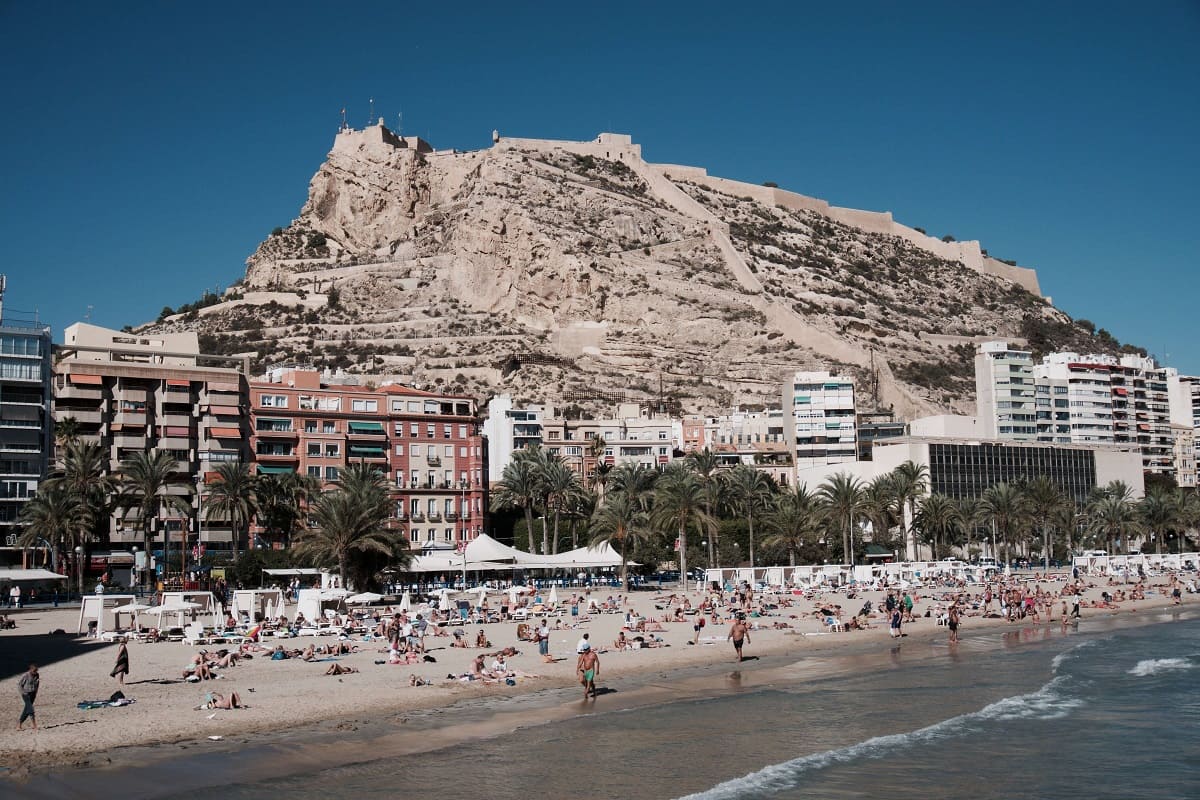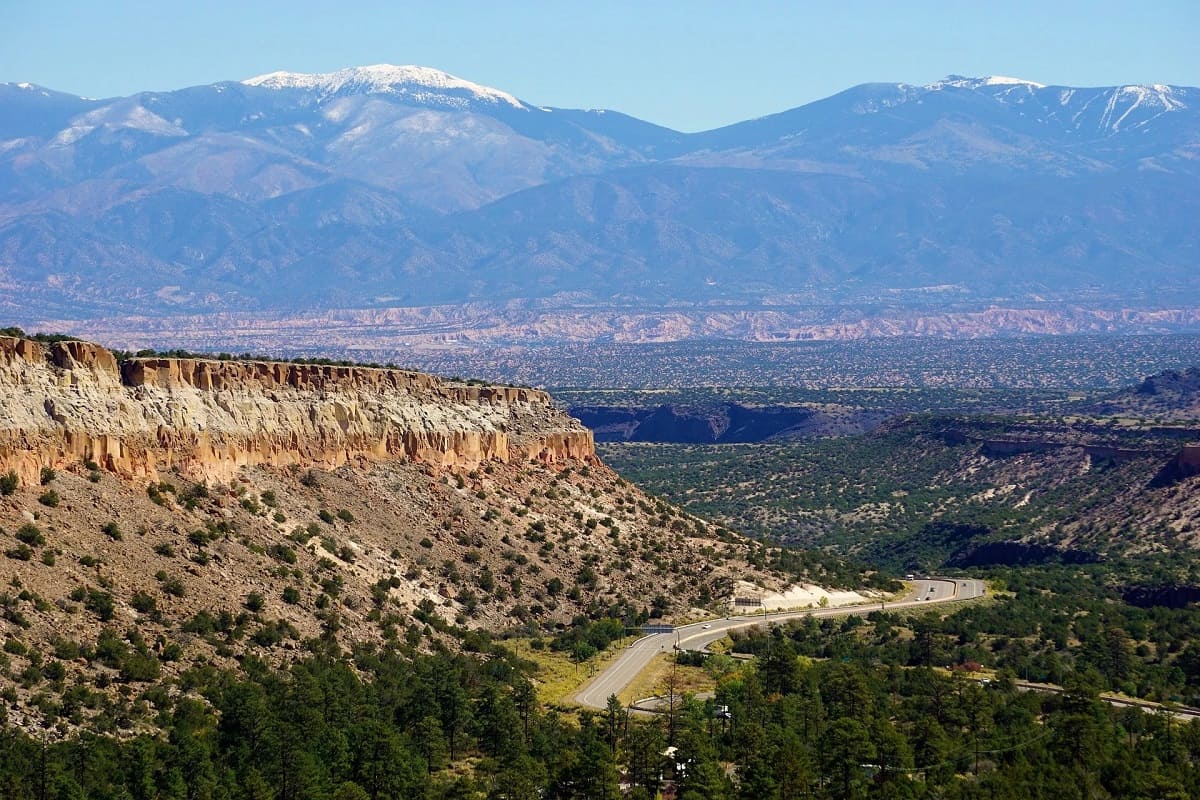Home>Weather and Climate>Climate In Spain: A Comprehensive Guide To Spain’s Weather And Climate


Weather and Climate
Climate In Spain: A Comprehensive Guide To Spain’s Weather And Climate
Published: March 3, 2024
Discover the diverse weather and climate of Spain with our comprehensive guide. From sunny beaches to snowy mountains, explore Spain's varied climate.
(Many of the links in this article redirect to a specific reviewed product. Your purchase of these products through affiliate links helps to generate commission for Temperatures.com, at no extra cost. Learn more)
Table of Contents
Introduction
Spain, a land of diverse landscapes and rich cultural heritage, is renowned for its varied climate. From the sun-drenched beaches of the Mediterranean coast to the snow-capped peaks of the Pyrenees, Spain's climate encompasses a wide spectrum of weather patterns. Understanding the nuances of Spain's climate is essential for both travelers and residents alike, as it influences everything from daily activities to regional agriculture and tourism.
In this comprehensive guide, we will delve into the intricate tapestry of Spain's weather and climate, exploring the distinct climatic regions, seasonal variations, and the impact of climate change. By gaining insights into Spain's climate, readers will develop a deeper appreciation for the country's natural diversity and be better equipped to navigate its ever-changing weather patterns.
Let's embark on a captivating journey through Spain's climatic tapestry, unraveling the unique characteristics that define each region and the factors that shape its weather patterns. Whether you're drawn to the vibrant energy of Andalusia, the lush greenery of Galicia, or the arid landscapes of the interior, understanding Spain's climate will enrich your experience and provide a deeper understanding of this captivating country.
Spain's Geographic and Climatic Regions
Spain's diverse topography gives rise to a wide array of climatic regions, each characterized by unique weather patterns and environmental features. These regions are influenced by factors such as latitude, proximity to the sea, and the presence of mountain ranges, resulting in a remarkable climatic diversity across the country.
Mediterranean Climate
The coastal areas of eastern and southern Spain, including popular destinations such as Barcelona, Valencia, and the Balearic Islands, are blessed with a Mediterranean climate. This region is known for its hot, dry summers and mild, wet winters. The abundant sunshine and moderate rainfall create ideal conditions for cultivating vineyards, olive groves, and citrus orchards, contributing to the region's renowned agricultural productivity.
Continental Climate
In central and northern Spain, a continental climate prevails, characterized by hot summers and cold winters. Cities like Madrid and Zaragoza experience significant temperature variations throughout the year, with scorching summers and chilly winters. The continental climate fosters diverse ecosystems, from the vast plains of Castile to the rugged terrain of the Pyrenees, offering a rich tapestry of natural landscapes.
Oceanic Climate
The northern coast of Spain, including regions such as Galicia and the Basque Country, enjoys an oceanic climate influenced by the Atlantic Ocean. Mild temperatures, ample rainfall, and lush greenery define this region, creating an ideal environment for the growth of dense forests and vibrant vegetation. The oceanic climate also contributes to the region's renowned seafood industry, with an abundance of marine life thriving in the coastal waters.
Read more: Spain Weather Guide for May
Semi-Arid Climate
The southeastern region of Spain, encompassing areas like Murcia and Almería, experiences a semi-arid climate characterized by low rainfall and high temperatures. This arid landscape is punctuated by rugged terrain and vast expanses of desert-like terrain, where hardy vegetation and unique wildlife have adapted to the challenging environmental conditions.
Mountain Climate
Spain's mountainous regions, including the Pyrenees in the north and the Sierra Nevada in the south, exhibit a mountain climate characterized by cooler temperatures and significant precipitation. The snow-capped peaks of these ranges not only attract winter sports enthusiasts but also play a crucial role in regulating the country's water supply, serving as natural reservoirs that feed rivers and sustain ecosystems throughout the year.
Spain's geographic and climatic regions form the foundation of the country's diverse natural beauty and cultural tapestry. Understanding the distinct characteristics of each region provides valuable insights into Spain's rich environmental heritage and the ways in which climate shapes the country's landscapes and livelihoods.
Mediterranean Climate
The Mediterranean climate, prevalent in the coastal areas of eastern and southern Spain, embodies a harmonious blend of warm, dry summers and mild, wet winters. This region, encompassing iconic destinations such as Barcelona, Valencia, and the Balearic Islands, is characterized by its abundant sunshine, moderate rainfall, and fertile landscapes. The unique climatic conditions have fostered a flourishing agricultural sector, with vineyards, olive groves, and citrus orchards thriving under the Mediterranean sun.
During the summer months, the Mediterranean coast basks in the warmth of the sun, creating an idyllic setting for beachgoers and outdoor enthusiasts. The clear blue skies and balmy temperatures draw visitors from around the world, seeking to immerse themselves in the vibrant energy of coastal cities and the tranquil beauty of secluded coves. The allure of the Mediterranean climate extends beyond leisure, as it provides an ideal environment for the cultivation of renowned agricultural produce. The fertile soils, coupled with the perfect balance of sunshine and rainfall, yield an abundance of fruits, vegetables, and olives, contributing to Spain's esteemed culinary heritage.
As the seasons transition to winter, the Mediterranean climate undergoes a subtle transformation, welcoming mild temperatures and refreshing rainfall. The rejuvenating showers nourish the earth, sustaining the lush vegetation and vibrant flora that define the region. The mild winters offer a welcome respite from the summer heat, creating a pleasant atmosphere for exploration and cultural immersion. The Mediterranean coast comes alive with a renewed sense of vitality, as the landscape is adorned with blossoming flowers and verdant foliage, signaling the arrival of spring.
The Mediterranean climate's influence extends beyond the natural environment, shaping the cultural fabric and lifestyle of the region. The leisurely pace of life, characterized by al fresco dining, siestas, and vibrant fiestas, reflects the harmonious relationship between the people and their surroundings. The warmth of the Mediterranean sun and the refreshing sea breezes inspire a sense of conviviality and celebration, infusing the coastal communities with a spirit of joy and camaraderie.
In essence, the Mediterranean climate embodies a captivating blend of natural beauty, agricultural abundance, and cultural vibrancy. Its impact resonates throughout the region, shaping the way of life and creating an enduring allure that captivates visitors and residents alike. The Mediterranean coast stands as a testament to the profound influence of climate on the fabric of society, offering a glimpse into a world where the rhythms of nature intertwine with the tapestry of human existence.
Continental Climate
The continental climate of Spain, predominantly found in the central and northern regions, encompasses a diverse tapestry of landscapes and weather patterns. This climatic region is characterized by its significant temperature variations, with scorching summers and chilly winters shaping the environmental dynamics and cultural rhythms of the area. Cities such as Madrid and Zaragoza bear witness to the distinct seasonal transitions that define the continental climate, offering a compelling insight into the interplay between nature and human experience.
During the summer months, the central and northern regions of Spain are enveloped in a blanket of heat, as the sun casts its radiant glow upon the expansive plains and rugged terrain. The intense warmth permeates the landscape, infusing the air with a palpable sense of energy and vitality. The long, sun-drenched days provide an ideal backdrop for outdoor pursuits, from leisurely strolls through historic city streets to adventurous hikes in the picturesque countryside. The vibrant hues of summer adorn the land, creating a captivating tapestry of golden fields, azure skies, and verdant meadows.
As the seasons transition to winter, the continental climate undergoes a dramatic shift, heralding the arrival of cold temperatures and occasional snowfall. The winter landscape exudes a serene beauty, as frost-kissed landscapes and snow-dusted peaks evoke a sense of tranquility and wonder. The chilly air carries a hint of anticipation, as communities prepare for seasonal festivities and embrace the timeless traditions that accompany the winter months. From bustling holiday markets to cozy gatherings around crackling fires, the winter season in the central and northern regions of Spain is imbued with a sense of warmth and conviviality.
The continental climate's influence extends beyond the natural environment, shaping the cultural fabric and lifestyle of the region. The seasonal ebb and flow of temperatures inspire a rich tapestry of traditions, from vibrant festivals celebrating the harvest to time-honored rituals that mark the passage of time. The resilience and adaptability of the people reflect the enduring bond between climate and culture, as they embrace the nuances of each season with a spirit of creativity and resilience.
In essence, the continental climate of Spain weaves a captivating narrative of seasonal contrasts and cultural richness, offering a glimpse into a world where the rhythms of nature intertwine with the tapestry of human existence. The distinct character of the central and northern regions, shaped by the interplay of scorching summers and chilly winters, invites exploration and discovery, beckoning visitors to immerse themselves in the vibrant mosaic of experiences that define this captivating climatic region.
Oceanic Climate
The oceanic climate of Spain, prevalent in the northern coastal regions including Galicia and the Basque Country, embodies a harmonious blend of mild temperatures, ample rainfall, and lush greenery. This unique climatic region is profoundly influenced by the proximity to the Atlantic Ocean, which exerts a moderating effect on temperatures and contributes to the region's distinctive environmental characteristics.
One of the defining features of the oceanic climate is its relatively narrow temperature range throughout the year. The maritime influence from the Atlantic Ocean ensures that summers remain mild and winters are relatively temperate, creating a stable and comfortable climate for both the natural environment and human inhabitants. This consistent moderation in temperatures fosters the growth of dense forests, vibrant vegetation, and an abundance of flora that thrives in the region's temperate conditions.
The ample rainfall that accompanies the oceanic climate plays a pivotal role in shaping the landscape and sustaining the region's rich biodiversity. The frequent showers nourish the earth, nurturing a verdant tapestry of flora that blankets the coastal areas and inland regions. The lush greenery, characterized by towering trees, vibrant ferns, and a myriad of wildflowers, creates a captivating tableau of natural beauty that defines the northern coast of Spain.
The oceanic climate's influence extends beyond the natural environment, permeating the cultural fabric and lifestyle of the region. The mild, temperate conditions provide an ideal setting for outdoor activities and leisurely pursuits, from scenic hikes along coastal trails to tranquil moments spent amidst the breathtaking landscapes. The maritime influence also extends to the region's renowned seafood industry, with the coastal waters teeming with an abundance of marine life that sustains a thriving fishing tradition and a rich culinary heritage.
In essence, the oceanic climate of Spain's northern coast weaves a captivating narrative of temperate tranquility and natural abundance, offering a glimpse into a world where the rhythms of nature intertwine with the tapestry of human existence. The distinct character of the region, shaped by its mild temperatures, ample rainfall, and lush greenery, invites exploration and discovery, beckoning visitors to immerse themselves in the vibrant mosaic of experiences that define this captivating climatic region.
Semi-Arid Climate
The southeastern region of Spain, encompassing areas such as Murcia and Almería, is characterized by a semi-arid climate that shapes the landscape with its low rainfall and high temperatures. This arid terrain, punctuated by rugged expanses and desert-like conditions, presents a unique environment where resilient vegetation and distinctive wildlife have adapted to the challenging climatic conditions.
The semi-arid climate creates a striking contrast to the lush greenery of the northern regions and the coastal areas, as the arid landscape unfolds with its rugged beauty and sun-drenched expanses. The scarcity of rainfall in this region poses a formidable challenge for sustaining vegetation, yet the hardy flora that thrives in the semi-arid climate showcases nature's remarkable resilience. The landscape is adorned with resilient plants such as succulents, drought-resistant shrubs, and hardy grasses, each embodying the tenacity required to flourish in this arid environment.
The high temperatures that define the semi-arid climate contribute to the region's distinct character, infusing the air with a palpable sense of warmth and vitality. The sun-drenched terrain, with its golden hues and rugged contours, creates a captivating backdrop for exploration and discovery. The arid climate has also shaped the architectural heritage of the region, with traditional whitewashed villages and fortified structures reflecting the ingenuity of adapting to the demands of the environment.
Despite the arid conditions, the semi-arid region of Spain harbors a rich tapestry of biodiversity, with unique wildlife species that have adapted to the challenges of the environment. From elusive reptiles that navigate the sun-baked terrain to resilient mammals that carve out a niche in the arid landscape, the semi-arid climate fosters a diverse ecosystem that thrives amidst the harsh conditions.
The semi-arid climate's influence extends beyond the natural environment, shaping the cultural fabric and lifestyle of the region. The resilience and resourcefulness of the inhabitants, who have adapted to the demands of the arid landscape, reflect a deep connection to the land and a spirit of perseverance. The semi-arid region stands as a testament to the remarkable interplay between climate and ecology, offering a glimpse into a world where nature's resilience and human ingenuity converge in a captivating tapestry of arid beauty.
In essence, the semi-arid climate of southeastern Spain weaves a captivating narrative of rugged beauty and natural resilience, offering a glimpse into a world where the rhythms of nature intertwine with the tapestry of human existence. The distinct character of the region, shaped by its low rainfall and high temperatures, invites exploration and discovery, beckoning visitors to immerse themselves in the captivating mosaic of experiences that define this unique climatic region.
Mountain Climate
The mountainous regions of Spain, including the Pyrenees in the north and the Sierra Nevada in the south, boast a distinctive mountain climate characterized by cooler temperatures and significant precipitation. These majestic ranges, adorned with snow-capped peaks and rugged terrain, create a captivating tapestry of natural beauty and environmental diversity.
The mountain climate exerts a profound influence on the ecosystems and landscapes of these regions, shaping the intricate balance of flora and fauna that thrive amidst the challenging alpine conditions. The cooler temperatures that prevail in the mountains create an ideal habitat for a diverse array of plant species, from hardy conifers that blanket the slopes to delicate alpine flowers that adorn the high-altitude meadows. The pristine mountain lakes and meandering streams sustain a rich tapestry of aquatic life, contributing to the region's ecological vibrancy.
One of the defining features of the mountain climate is the significant precipitation that graces these elevated landscapes. The snowfall that blankets the peaks during the winter months not only creates a breathtaking winter wonderland but also serves as a vital source of freshwater that sustains the surrounding ecosystems. As the snow melts in the spring and summer, it feeds the mountain streams and rivers, nurturing the verdant valleys and sustaining a myriad of plant and animal species.
The mountain climate's influence extends beyond the natural environment, shaping the cultural fabric and lifestyle of the region. The snow-capped peaks and pristine alpine landscapes beckon outdoor enthusiasts and adventure seekers, offering a playground for winter sports and exhilarating alpine pursuits. The mountain communities, steeped in rich traditions and a deep connection to the land, embody a spirit of resilience and reverence for the awe-inspiring natural surroundings.
In essence, the mountain climate of Spain's majestic ranges weaves a captivating narrative of alpine grandeur and ecological richness, offering a glimpse into a world where the rhythms of nature intertwine with the tapestry of human existence. The distinct character of the mountainous regions, shaped by their cooler temperatures and abundant precipitation, invites exploration and discovery, beckoning visitors to immerse themselves in the captivating mosaic of experiences that define this breathtaking climatic region.
Factors Affecting Spain's Climate
Spain's climate is influenced by a myriad of factors that shape the diverse weather patterns and environmental conditions observed across the country. These factors play a pivotal role in defining the unique climatic regions and contributing to the rich tapestry of natural landscapes that characterize Spain.
-
Geographic Location: Spain's geographical position at the crossroads of Europe and Africa, with its proximity to the Atlantic Ocean and the Mediterranean Sea, exerts a profound influence on its climate. The country's southern and eastern coasts are bathed in the warm, maritime influences of the Mediterranean and the Atlantic, fostering the development of Mediterranean and oceanic climates. In contrast, the interior regions experience continental and semi-arid climates, reflecting the impact of the surrounding landmass and topographical features.
-
Mountain Ranges: The presence of prominent mountain ranges, such as the Pyrenees and the Sierra Nevada, significantly influences Spain's climate. These majestic peaks act as natural barriers, affecting the distribution of rainfall and creating distinct microclimates. The mountains contribute to the formation of the mountain climate, characterized by cooler temperatures and ample precipitation, while also influencing wind patterns and weather systems across the country.
-
Prevailing Wind Patterns: Spain's climate is shaped by prevailing wind patterns that originate from different directions, influencing temperature, humidity, and precipitation levels. The warm, dry winds from the Sahara Desert, known as the "Sirocco" or "Calima," can bring periods of intense heat and dust storms to southern Spain, particularly during the summer months. In contrast, the moist, westerly winds from the Atlantic Ocean contribute to the maritime climate experienced along the northern coast.
-
Ocean Currents: The ocean currents surrounding Spain, notably the warm Mediterranean currents and the cooler Atlantic currents, play a crucial role in regulating coastal temperatures and influencing regional climates. These currents contribute to the moderation of temperatures along the coastlines, creating favorable conditions for marine life and influencing the development of coastal climates.
-
Elevation: The diverse topography of Spain, characterized by plains, plateaus, and mountainous regions, results in varying elevations that contribute to the formation of distinct climate zones. Higher elevations experience cooler temperatures and greater precipitation, giving rise to the mountain climate, while lower-lying areas are subject to the influences of continental, Mediterranean, and semi-arid climates.
Understanding the interplay of these factors provides valuable insights into the complexities of Spain's climate and the diverse environmental conditions that define the country's natural heritage. By recognizing the multifaceted influences that shape Spain's climate, we gain a deeper appreciation for the intricate balance of natural forces that converge to create the captivating tapestry of weather and climate observed throughout the country.
Seasonal Variations
The seasonal variations in Spain paint a vivid portrait of the country's diverse climate, offering a captivating journey through the ever-changing tapestry of weather patterns and natural rhythms. From the sun-drenched days of summer to the crisp embrace of winter, each season unfolds with its own unique charm and character, shaping the landscapes and cultural experiences across the country.
Summer
The summer months in Spain usher in a symphony of warmth and vitality, as the Mediterranean coast basks in the golden glow of the sun and the northern regions come alive with vibrant energy. The long, sun-drenched days create an ideal setting for outdoor pursuits, from leisurely beach outings to exhilarating hikes in the mountains. The coastal towns and cities pulse with life, as locals and visitors alike embrace the leisurely pace of summer, savoring the abundance of cultural festivals, open-air markets, and al fresco dining experiences. The Mediterranean climate casts its enchanting spell, inviting travelers to immerse themselves in the joyous rhythms of coastal living and the timeless allure of the Spanish summer.
Autumn
As summer transitions to autumn, Spain undergoes a subtle transformation, unveiling a tapestry of rich colors and a sense of tranquility. The landscapes are adorned with the warm hues of autumn foliage, creating a picturesque backdrop for exploration and discovery. The vineyards of the Mediterranean region burst with activity, as the grape harvest season unfolds, offering a glimpse into the time-honored traditions of winemaking and the celebration of the land's bounty. In the northern regions, the oceanic climate infuses the air with a refreshing crispness, beckoning travelers to embrace the natural beauty of the changing seasons and the cultural richness that accompanies the autumnal months.
Winter
Winter in Spain unfolds with a sense of enchantment, as the mountainous regions don their snow-covered mantles and the central plains embrace the festive spirit of the holiday season. The mountain climate creates a winter wonderland, inviting enthusiasts to partake in exhilarating alpine pursuits and revel in the breathtaking beauty of snow-capped peaks. In the interior regions, the continental climate sets the stage for traditional holiday celebrations, as historic cities come alive with festive markets, dazzling lights, and a palpable sense of warmth and conviviality. The winter season offers a glimpse into Spain's cultural heritage, as time-honored traditions and seasonal festivities illuminate the country's rich tapestry of customs and celebrations.
Read more: Spain Weather: Monthly Climate Guide
Spring
As winter gives way to spring, Spain blossoms with renewed vitality, as the landscapes are adorned with a profusion of wildflowers and the promise of new beginnings. The Mediterranean coast bursts with the vibrant colors of spring, as the countryside awakens with the fragrant blooms of citrus orchards and the lush greenery of vineyards. The oceanic climate creates a sense of rejuvenation along the northern coast, as the verdant landscapes and coastal trails beckon outdoor enthusiasts to embrace the natural beauty of the season. Spring in Spain embodies a sense of renewal and vitality, offering a captivating tableau of cultural traditions, natural splendor, and the timeless allure of the changing seasons.
The seasonal variations in Spain offer a captivating glimpse into the country's rich tapestry of climate and culture, inviting travelers to embark on a journey through the ever-changing landscapes and the timeless rhythms of nature. Each season unfolds with its own unique allure, painting a vibrant portrait of Spain's diverse climate and the enduring beauty of its natural heritage.
Extreme Weather Events
Spain, despite its reputation for sunny and temperate weather, is not immune to extreme weather events that can profoundly impact the country's landscapes and communities. From intense heatwaves to torrential rains and occasional snowstorms, Spain experiences a diverse array of extreme weather phenomena that underscore the dynamic nature of its climate.
One of the most notable extreme weather events in Spain is the occurrence of heatwaves, particularly during the summer months. These prolonged periods of scorching temperatures can pose significant challenges, affecting public health, agriculture, and the environment. The intense heat can lead to heat-related illnesses, placing strain on healthcare systems and prompting public health advisories to ensure the well-being of residents and visitors. The agricultural sector also grapples with the impact of heatwaves, as crops and livestock are vulnerable to the stress of prolonged high temperatures, necessitating adaptive measures to mitigate potential losses. Additionally, the environment faces heightened risks during heatwaves, with the potential for wildfires to erupt and spread rapidly, posing threats to ecosystems and human settlements.
In contrast to the searing heat, Spain also experiences extreme rainfall events that can result in flash floods and widespread inundation. The Mediterranean region, in particular, is susceptible to heavy downpours that can overwhelm drainage systems and trigger rapid flooding in urban and rural areas. These intense rainfall events can disrupt transportation networks, inundate agricultural lands, and pose risks to public safety. The impact of flash floods underscores the need for robust infrastructure and emergency preparedness to mitigate the consequences of extreme precipitation.
Furthermore, Spain's mountainous regions are prone to significant snowfall, especially during the winter months. While the snow-capped peaks create picturesque landscapes and support winter tourism, heavy snowfall can also pose challenges for transportation and infrastructure maintenance. The mountain climate, characterized by abundant snow, necessitates diligent snow removal efforts and proactive measures to ensure the safety and accessibility of mountainous areas.
The occurrence of extreme weather events in Spain underscores the importance of resilience, preparedness, and adaptive strategies to mitigate the impact of such phenomena. From heatwaves and heavy rainfall to snowstorms, these events serve as reminders of the dynamic and occasionally unpredictable nature of Spain's climate, prompting ongoing efforts to enhance resilience and safeguard communities and ecosystems against the challenges posed by extreme weather.
Climate Change and its Impact on Spain
Climate change poses significant challenges for Spain, exerting far-reaching impacts on the country's ecosystems, economy, and societal well-being. The effects of climate change are increasingly evident across Spain, manifesting in altered weather patterns, rising temperatures, and shifts in precipitation dynamics.
One of the most pronounced impacts of climate change in Spain is the escalation of heatwaves and extreme heat events. Rising temperatures have led to more frequent and intense heatwaves, posing substantial risks to public health, particularly among vulnerable populations. The agricultural sector also grapples with the consequences of prolonged heat, as crops and livestock face heightened stress and reduced productivity. Additionally, the heightened risk of wildfires during periods of extreme heat underscores the urgent need for proactive measures to mitigate the impact on natural landscapes and human settlements.
Changes in precipitation patterns further underscore the impact of climate change on Spain. The country faces a complex interplay of challenges, including periods of intense rainfall leading to flash floods and the potential for prolonged droughts in certain regions. These shifts in precipitation dynamics pose significant challenges for water resource management, agricultural sustainability, and the resilience of ecosystems.
Coastal regions are particularly vulnerable to the effects of climate change, as rising sea levels and increased frequency of extreme weather events threaten coastal infrastructure and ecosystems. The potential for coastal erosion, inundation, and saltwater intrusion presents multifaceted challenges that necessitate adaptive strategies and long-term planning to safeguard coastal communities and natural habitats.
The impact of climate change extends beyond environmental concerns, influencing economic sectors such as tourism, agriculture, and energy. The need for adaptive strategies and sustainable practices has become increasingly urgent, as Spain navigates the complex realities of a changing climate.
Addressing the challenges posed by climate change requires a multifaceted approach, encompassing mitigation efforts to reduce greenhouse gas emissions, adaptation strategies to enhance resilience, and proactive measures to safeguard ecosystems and communities. By acknowledging the far-reaching impact of climate change and embracing collaborative, science-based solutions, Spain can navigate the complexities of a changing climate and foster a sustainable, resilient future for generations to come.
Conclusion
In conclusion, Spain's weather and climate encompass a rich tapestry of natural diversity, cultural vibrancy, and environmental resilience. The country's geographic and climatic regions, ranging from the sun-kissed Mediterranean coast to the snow-capped peaks of the mountainous ranges, offer a captivating mosaic of weather patterns and landscapes. The interplay of factors such as geographic location, mountainous terrain, prevailing wind patterns, ocean currents, and elevation contributes to the formation of distinct climatic zones, each with its own unique characteristics and influences.
The seasonal variations in Spain, from the warmth of summer to the tranquility of autumn, the enchantment of winter, and the renewal of spring, paint a vivid portrait of the country's diverse climate and cultural heritage. Each season unfolds with its own allure, shaping the landscapes and rhythms of life across the country.
While Spain's climate presents a captivating array of natural beauty and cultural richness, the country also faces challenges posed by extreme weather events and the impacts of climate change. Heatwaves, heavy rainfall, and the escalation of extreme weather phenomena underscore the dynamic and occasionally unpredictable nature of Spain's climate, prompting the need for resilience, preparedness, and adaptive strategies.
The effects of climate change, including rising temperatures, altered precipitation patterns, and coastal vulnerabilities, necessitate proactive measures to mitigate the impact on ecosystems, communities, and economic sectors. By embracing science-based solutions, collaborative efforts, and sustainable practices, Spain can navigate the complexities of a changing climate and foster a resilient, sustainable future.
Understanding Spain's weather and climate not only enriches our appreciation for the country's natural heritage but also provides valuable insights into the intricate interplay of environmental forces and human experiences. As we continue to explore and cherish the diverse landscapes and cultural traditions that define Spain, it is essential to recognize the profound influence of climate on the country's past, present, and future. Through a harmonious balance of preservation, adaptation, and stewardship, Spain can continue to thrive amidst the ever-changing tapestry of weather and climate, ensuring a vibrant legacy for generations to come.











